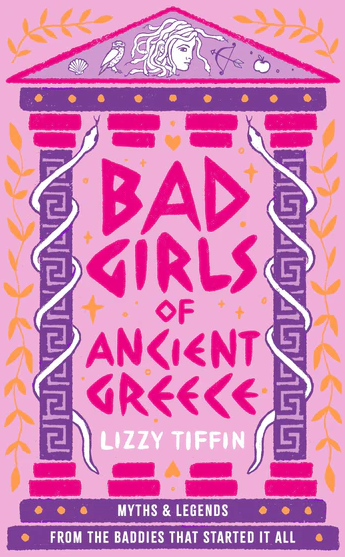Review: Bad Girls of Ancient Greece
Don’t let the pink colour and charming cover illustration deceive you: this book is far from a young adult romcom or a simplistic recounting of the Greek myths. Witty in its delivery and pertinent in its commentary, Bad Girls of Ancient Greece: Myths & Legends from the Baddies that Started it All proves a necessary addition to the current rise in fictional and non-fictional revisits to the beloved realm of gods, heroes, and monsters.
“Classical history shouldn’t feel like a closed club where the password is a Latin phrase that you can barely pronounce – it’s an interesting, exciting, and colourful world we should all be able to engage in and enjoy”, writes author Lizzy Tiffin in the introduction to her non-fiction debut.
This intention shines through in the conversational style that draws in the reader from the outset. From the vengeful Olympian Queen Hera to the fear-inducing Lamia, she takes readers on a tour across mythological Greece, reframing its various narratives to recognise the wives, lovers, goddesses, and mothers as being individually distinct from their relationships to male characters.
Some may be tempted to assume that a humorous approach would result in a simplistic read with little educational merit beyond the surface level facts, that only academic writing can hope to inform those new to the ancient world. Books like Bad Girls of Ancient Greece show that this need not be the case, as within the short, self-contained entries, Tiffin’s writing style captures the personalities and backgrounds of each character in a manner that is both memorable and concise. Add to this the chapter titles - or categories - the female characters fall under, such as ‘Twisted Sisters’ and ‘Damsels of Distress’, and the book becomes an entertaining means to learn about Greek mythology without the sense that readers have been transported to the classroom.
Despite these strengths, it would have been nice to see artistic renditions of the characters accompany some of the entries to further engage readers and help them put faces to some of the numerous names in the book. Irrespective of this minor criticism, the value of making Classical Studies accessible to as wide a readership as possible cannot be understated.
Particularly in a field that has long been associated with white, wealthy, cisgender men, women can use encouragement that there is a space for them should they choose to pursue the subject.
Furthermore, the existence of Bad Girls of Ancient Greece and other feminist reclamations of Classics holds great promise for the expansion of queer, POC and disability studies with regards to the ancient world.
If we are to protect and champion the right to the humanities for all, we need voices like Tiffin’s to challenge the notion that Classics is a badge of honour for society’s elite to lord over those who did not receive a private education.
An inspired, pertinent, and welcoming introduction to a mythology whose influence and educational importance has outlived the civilisation that conceived it, Bad Girls of Ancient Greece is a reliable starting point for newcomers as well as a point of reference for seasoned enthusiasts of Classics and/or Greek mythology.
About the Reviewer
Carlotta Vincenzi is a final year undergraduate student in English and Film Studies. Since their high school years they have fostered what has become a lifelong enthusiasm for the ancient world.


